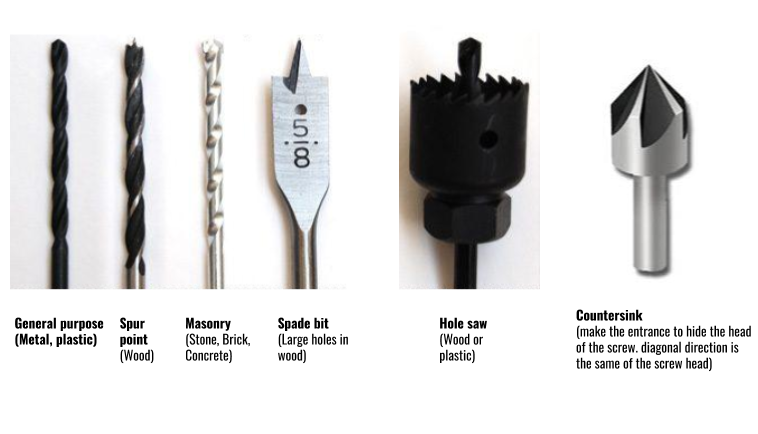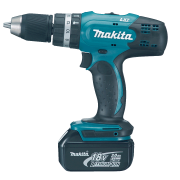Difference between revisions of "Makita DHP453 Hammer driver drill"
From Fab Lab Bcn WIKI
| (4 intermediate revisions by one user not shown) | |||
| Line 1: | Line 1: | ||
[[Category:Hand tools]] | [[Category:Hand tools]] | ||
| − | + | __NOTOC__ | |
[[File:Makita-BHP453.png| thumb |Makita DHP453 Hammer driver drill]] | [[File:Makita-BHP453.png| thumb |Makita DHP453 Hammer driver drill]] | ||
| − | + | '''Description:''' | |
| + | |||
| + | A driver drill is a tool primarily used for making round holes or driving fasteners. It is fitted with a bit, either a drill or driver, depending on application, secured by a chuck. It also includes a hammer function. | ||
| + | |||
| + | A cordless drill is an electric drill which uses rechargeable batteries. They are available in the hammer drill configuration and most have a clutch, which aids in driving screws into various substrates while not damaging them. | ||
==How to use== | ==How to use== | ||
| + | *Choose the correct drill bit. | ||
| + | *Fit the drill bit firmly into the chuck. You may be able to do this by hand. | ||
| + | *Hold the drill steady and push it into the material you're drilling. If it takes more than light force to drill the hole, you're probably using the wrong bit. | ||
| + | *Adjust the clutch. Each drill has a twistable collar to adjust the torque. The higher the number, the more torque (rotational force) the drill will apply. | ||
| + | *Avoid overheating the drill bit. | ||
| + | *If the battery is too low, swap it with a spare battery pack. | ||
| − | *Drill and screwdriver | + | ==Features== |
| + | *Drill and screwdriver | ||
*Two speeds, less speed more power, more speed less power | *Two speeds, less speed more power, more speed less power | ||
*Gear number: | *Gear number: | ||
| − | * | + | ** High number (14) more pressure and power |
| − | * | + | ** Low number (1) less power for not damage the material when you break the bottom surface |
*Screw position | *Screw position | ||
| − | *Hammer position, not just spin (not for metal and wood) | + | *Hammer position, not just spin (used for concrete and not for metal and wood) |
| + | |||
| + | ==Drills== | ||
| + | Using a bit made from the wrong material can cause the bit or the material you're drilling to break. You can use a general-purpose bit on most wood; a masonry bit for stone, brick or concrete; an HSS (high speed steel) bit on most metals | ||
| + | [[File:Drills.png]] | ||
| + | ==Screw== | ||
| + | [[File:Screws.png]] | ||
==External link== | ==External link== | ||
http://www.makitauk.com/products/front/?model=BHP453Z | http://www.makitauk.com/products/front/?model=BHP453Z | ||
Latest revision as of 12:15, 27 April 2020
Description:
A driver drill is a tool primarily used for making round holes or driving fasteners. It is fitted with a bit, either a drill or driver, depending on application, secured by a chuck. It also includes a hammer function.
A cordless drill is an electric drill which uses rechargeable batteries. They are available in the hammer drill configuration and most have a clutch, which aids in driving screws into various substrates while not damaging them.
How to use
- Choose the correct drill bit.
- Fit the drill bit firmly into the chuck. You may be able to do this by hand.
- Hold the drill steady and push it into the material you're drilling. If it takes more than light force to drill the hole, you're probably using the wrong bit.
- Adjust the clutch. Each drill has a twistable collar to adjust the torque. The higher the number, the more torque (rotational force) the drill will apply.
- Avoid overheating the drill bit.
- If the battery is too low, swap it with a spare battery pack.
Features
- Drill and screwdriver
- Two speeds, less speed more power, more speed less power
- Gear number:
- High number (14) more pressure and power
- Low number (1) less power for not damage the material when you break the bottom surface
- Screw position
- Hammer position, not just spin (used for concrete and not for metal and wood)
Drills
Using a bit made from the wrong material can cause the bit or the material you're drilling to break. You can use a general-purpose bit on most wood; a masonry bit for stone, brick or concrete; an HSS (high speed steel) bit on most metals


